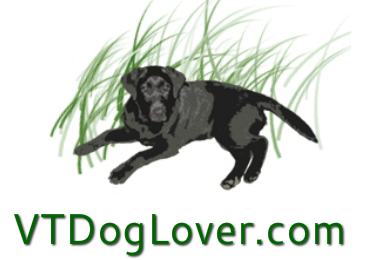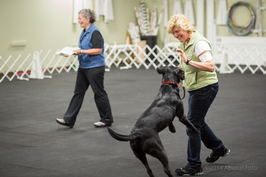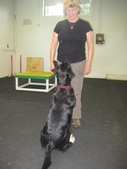The “perch”, a small raised platform for the dog’s front feet, can be a very useful tool to help teach the body mechanics needed. I first learned about the perch from an agility friend a bunch of years ago. Since that time, “perch work” has grown in popularity across many dog sports and is now widely used as a training tool by top obedience and Schutzhund trainers in the US and abroad.
For the perch itself, It’s helpful to start with an object several inches tall (3 – 10 or so, depending on your dog’s size) to clearly isolate front feet from back. Once your dog has the idea, a lower object can be used and then faded completely. You can go fancy or basic, but whatever you use should be sturdy and stable (wobbling will set you back!), non-slip, and large enough for front feet but not so large as to encourage the dog to put her whole body on it (that would then be a platform, another useful tool). Feel free to start with something larger than you will eventually use if your dog has trouble putting her front feet on it at first. An upside down heavy rubber feed tub or hard plastic bowl fitted with a non-slip surface, a thick phone book wrapped in heavy duty non-slip tape, or a wide upside down flower pot or base are easy choices to find. Creative types can make perches and platforms from wood or sturdy foam.
I’ll describe the basic steps below.
Step one is to teach the dog to eagerly put her front feet on the perch. A clicker is useful to mark the moment she’s up, but a marker word (e.g., “Yes”) is fine, too. You can lure the dog onto the object and mark and reward when her front feet arrive on the perch. You could also wait for her to step up (no lure) if she’s used to offering behaviors involving her front feet. In any case, be sure to deliver the treat with the dog’s head up and over the perch so her front feet stay anchored. Toss a reset cookie to get the dog off (use visible food to avoid snuffling!) or simply release her off so she can learn that getting up on the perch is what gets the reward at first.
Once your dog is able to get her front feet on and stay up comfortably, toss a reset cookie directly behind her, telling her to "Get it" or "Find it", and encourage her to come straight back to you, ending up in front again. If she comes in at an angle, move YOURSELF so she lands in a perfect front position (no sit required). This will give her the picture of having her spine aligned perfectly with the center of your body. You can feed her at the center of your body, or spit a cookie if she can catch, to further reinforce the position. Toss another reset cookie and repeat. Do this several times, then toss a reset cookie off to one side, align yourself so she comes in straight, feed at center of your body, then toss to the other side. Do this in short sessions (1 - 5 minutes) over the course of a few days so your dog really gets happy about front feet on the perch.
The next step is designed to help your dog learn to move her hind feet while keeping her front feet on the perch. This is useful for both finding front after retrieves and jumps and finding heel position. With her front feet on the perch, encourage her to move a back foot to the side while keeping her front feet anchored. You can do this in several ways, but keeping a food lure close to the front and center of your body and moving yourself slightly around the perch (stay very close) so the dog moves to stay in front of you tends to work well. You can also try moving yourself towards one of the dog’s hips, putting spacial (or even physical) pressure on her to move at first, marking and rewarding as above. Or, you could wait for her to offer back foot movement (although you might be waiting a long time unless she's really savvy about shaping!). In the beginning, mark and reward the SLIGHTEST hind end movement - or even the weight shift that would precede hind foot movement. Your dog will catch on quickly if you break the exercise down into tiny steps. Remember to treat above your dog's head so her front feet stay on the perch.
Be sure to watch your dog's hind end and not her eyes, lest you get in a staring contest! Do 5 or 10 reps and take a break, letting her get off and removing access to the perch (pick it up!). Stay at this step until the dog is moving around smoothly as you move. Be sure to mark when the dog is MOVING her back feet, not when she stops (its fine to feed after she hears the marker and stops for her cookie).
Next, have her go the other direction. It’s easy to focus on having her move only toward your left if heeling and finishes are your goal, but it doesn’t create a balanced dog. Plus, you may want to do freestyle, agility or another activity one day where comfort on your right side is useful.
In these beginning steps, you are basically asking your dog to remain in the “front” position as you move to encourage her to move. It’s fine to help the dog with a food lure. Just remember, the body follows the head/nose, so be aware of your hand position. If the dog isn’t moving in the manner you’re looking for, your food lure probably isn’t in the right place!
I like to fade the food lure at this point before moving on. This makes it easier for our dogs to understand how to find front in addition to ultimately how to find heel. To fade the lure, place your hands at your sides (or behind your back) and wait for the dog to look up. Mark and reward at the center of your body (or from your mouth) a few times. Then, move yourself slightly as above and wait for the dog to offer the slightest hind foot movement to stay in front. Mark and reward.
Next, stand to the right side of the perch and have your dog step onto it beside you, standing in heel position. Use a lure, if needed. You could do this by a wall or barrier at first to encourage your dog to be straight by your side. Move a bit to your right around the perch and encourage your dog to move into you. Using a lure to turn her nose away from you can help the hind end come in. Be sure to keep the food up over the dog’s head to keep her on the perch and to prevent her neck from bending excessively. Mark and reward VERY small steps at first, then ask for more. Then, stand still and ask her to move a few steps into you on her own. Once she’s moving smoothly, fade your lure if you’re using one. If your dog is coming into you reliably as you move, you can name it (“heel”, “get it in”, etc.).
You can do this in the other direction, so your dog moves away from you to stay in heel position, and then try it with your dog on your right side (not so easy for many of us, or our dogs!).
If you have questions or would like to try it with your dog, feel free to email me … or better yet, come to obedience class!



 RSS Feed
RSS Feed